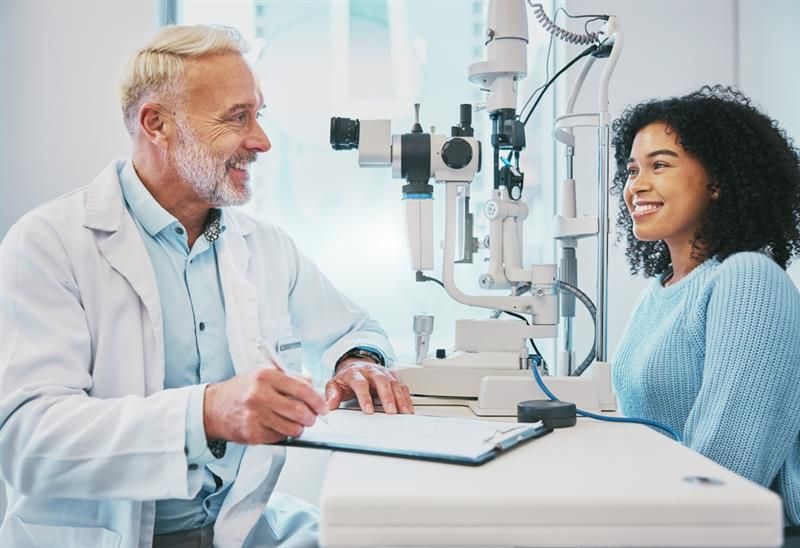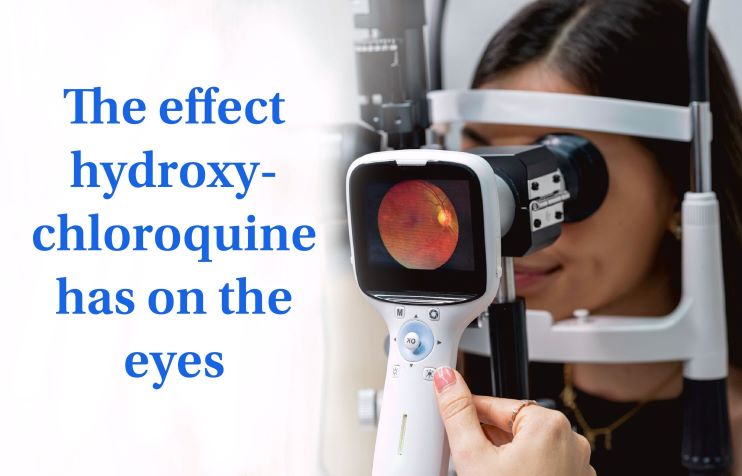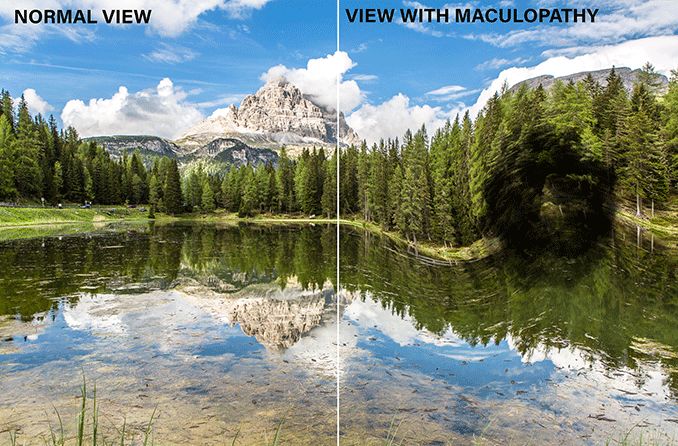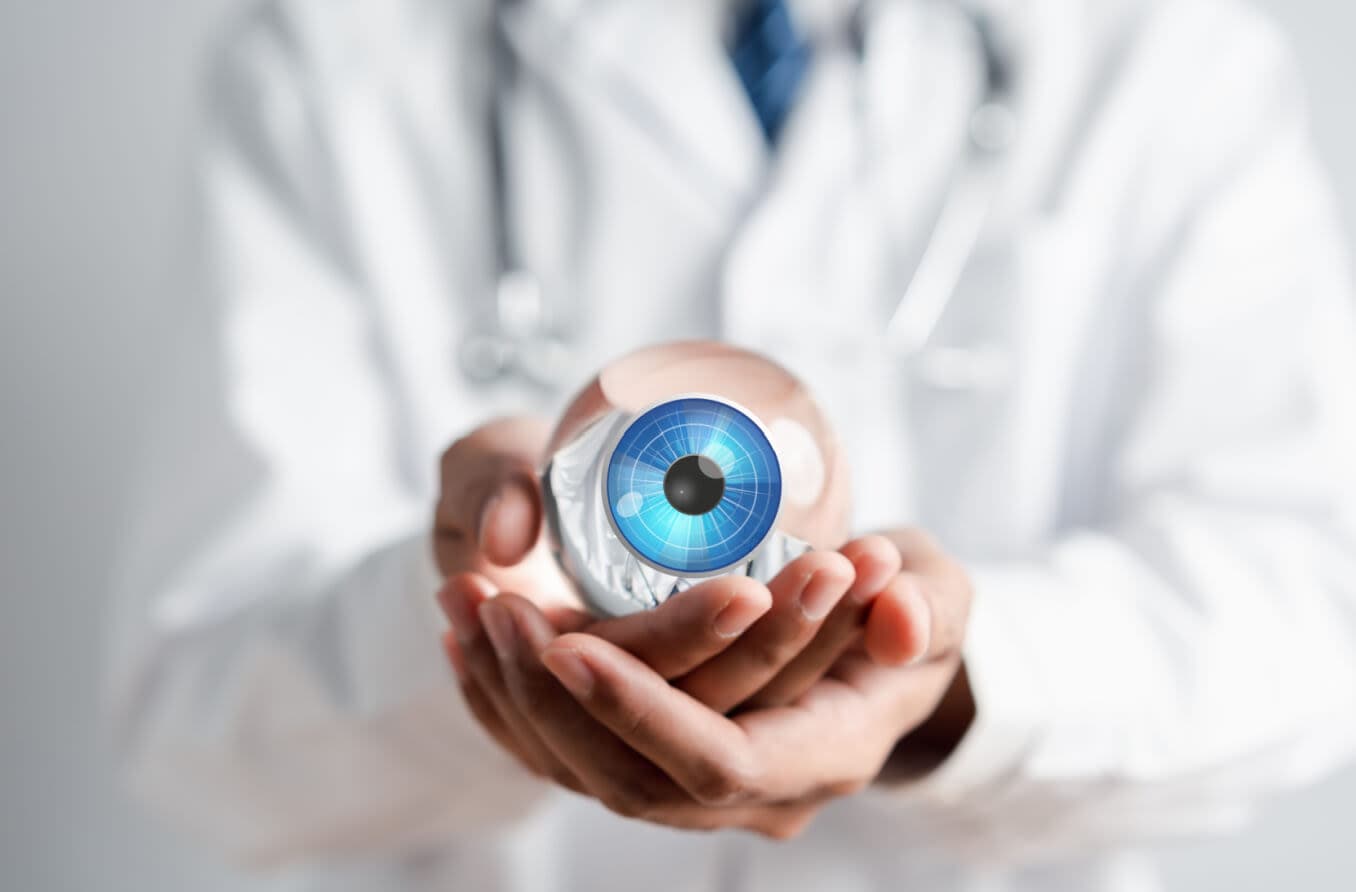What is hydroxychloroquine and why is it used?
Hydroxychloroquine (Plaquenil) is a drug commonly prescribed to treat malaria and inflammatory conditions, including autoimmune diseases like lupus. Although rare, it can affect your eyes over time, so it’s important to monitor any eye side effects to help protect your vision.
Hydroxychloroquine (pronounced “hye-drox-ee-KLOR-oh-kwin”) is a disease-modifying anti-rheumatic drug (DMARD). A rheumatic disease is any disease that causes pain or inflammation in the joints and surrounding areas.
For inflammatory conditions, hydroxychloroquine works by blocking the release of chemicals involved in inflammation. This can reduce swelling, pain and joint stiffness. It also helps regulate a hyperactive immune system in autoimmune diseases (any disorder where the body’s immune system attacks its own healthy tissues by mistake).
For malaria, hydroxychloroquine works by targeting the parasite responsible for the infection. The drug chloroquine was originally used for malaria. However, hydroxychloroquine is more commonly used now because of its less toxic side effects.
Hydroxychloroquine is the generic name of the medication. It is also available under the brand names Plaquenil, Quineprox and Sovuna.
How it works
The exact mechanisms for how hydroxychloroquine works are not fully understood. However, the drug is able to pass through cell membranes, where it can build up in lysosomes. Lysosomes are like the digestive system of the cell. They contain enzymes that break down different substances. Hydroxychloroquine inhibits these enzymes, interfering with normal cellular functions.
Lysosomes are also involved in immunity and the progression of several diseases. Interfering with normal lysosome processes may be how hydroxychloroquine affects the autoimmune response and eases inflammation.
Hydroxychloroquine and COVID
Hydroxychloroquine has also been used to treat COVID-19 because of its suggested antiviral effects. However, the evidence for its usefulness is inconclusive. Currently, using it to treat COVID-19 is not recommended.
Eye side effects of hydroxychloroquine
Over time, hydroxychloroquine use can lead to retinopathy, or damage to the retina. The retina is the structure in the back of your eye that senses light. The medication can affect certain parts of the retina, including:
- Photoreceptors – Photoreceptors are the cells that convert light into visual information for the brain. There are two special types — rods and cones.
- Macula – The macula is the central part of the retina. It helps you see objects that are directly in front of you (central vision).
- Retinal pigment epithelium (RPE) – The RPE is the retina’s outermost layer. Cells in the RPE get rid of old, outer photoreceptors by engulfing them. This process is crucial for maintaining healthy, functional photoreceptors.
Hydroxychloroquine can cause side effects from the way it impacts these structures.
Retinal toxicity (hydroxychloroquine retinopathy)
The risk of retinal toxicity from hydroxychloroquine depends on the dose and how long you’ve been taking the medication. It is low (less than 1%) for up to five years. Between five and 10 years, the risk rises anywhere from 2% to 7.5% or higher. After 20 years, it increases to nearly 20%.
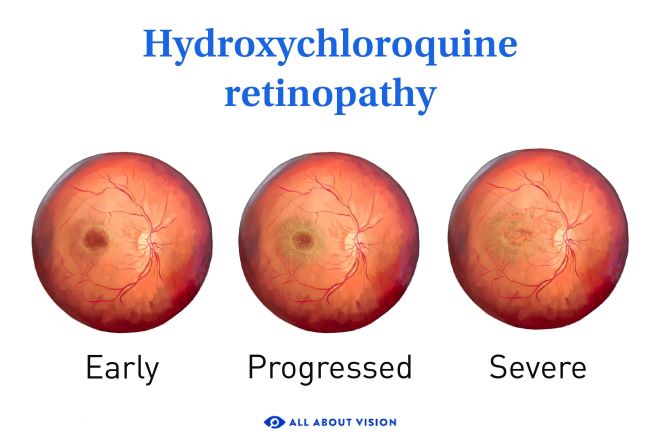
How hydroxychloroquine retinopathy happens isn’t known for sure. It is thought that the medication can bind to certain cells (like melanin cells) in your retina and cause changes in how these cells work.
When hydroxychloroquine interferes with lysosome function, the lysosomes in the RPE may not be able to remove old photoreceptor cells that no longer work. When these cells aren’t removed, they will accumulate and cause damage to both photoreceptors and RPE cells.
If damage to the macula occurs, it can cause bull’s-eye maculopathy. The name refers to the pattern caused by the damage — it looks like a discolored ring around the very center of the macula, similar to a bull's eye.
There might not be any symptoms in the initial stages of retinal damage. However, if symptoms do occur, they may include:
- Changes in color vision (trouble seeing red objects in particular)
- Reduced or blurred vision
- Blind spots, including missing central vision
- Difficulty reading
- Glare sensitivity
- Flashing lights
- Metamorphopsia (when your vision is distorted)
Symptoms of bull’s-eye maculopathy may also include eye floaters, dark spots or low vision (permanent vision impairment that can’t be corrected with traditional methods like glasses, contacts or surgery).
If ignored, damage over time may lead to vision loss.
Corneal deposits
Hydroxychloroquine can also cause corneal deposits, or a buildup of pigment on the surface of the cornea (the clear front surface of the eye). These deposits can appear anywhere from two weeks to a few months after beginning the medication.
Exactly how hydroxychloroquine causes these buildups is not known. It is thought that, after entering lysosomes, hydroxychloroquine binds to lipids (organic compounds that do not dissolve in water). These compounds accumulate inside the lysosomes in the corneal epithelium, forming “verticillata” (a whorl or vortex pattern). These deposits are sometimes referred to as vortex keratopathy.
Corneal deposits don’t usually cause any symptoms. However, they can sometimes lead to:
- Seeing halos around lights
- Sensitivity to light (photophobia)
- Blurry vision
But there are typically no serious lasting complications. Symptoms will usually disappear on their own after the drug is stopped.
Other rare eye issues
In rare cases, hydroxychloroquine may affect the ciliary body of the eye, causing blurred vision when looking up close. The ciliary body contains the ciliary muscle, which is what changes the shape of your eye’s crystalline lens. This process is what allows you to focus on objects close by, also known as accommodation.
The ciliary body contains pigment, so there are melanin cells for the hydroxychloroquine to bind to. This is likely why the medication causes this effect. However, it is extremely rare and generally reversible.
What increases your risk of eye problems?
You should not take hydroxychloroquine if you have pre-existing eye problems, especially a condition involving the retina or other areas inside your eye. Additionally, many of the eye side effects are more likely to happen with a higher dose, which is considered to be more than 5 milligrams per kilogram of body weight per day.
The risk is also greater the longer you’ve been taking the drug. Generally, it’s lower if the medication has been taken for under five years.
In addition to a high daily dose and pre-existing retinopathy, the American Academy of Ophthalmology identified the following risk factors for hydroxychloroquine retinopathy:
- Obesity
- Small stature
- Retinal disease
- Liver or kidney disease, or reduced kidney function
- Use of tamoxifen (a medication that blocks estrogen to treat or prevent breast cancer)
Starting the medication at an older age (45 or older) and being female may also be risk factors.
In addition, certain demographic groups seem to be at risk for developing a particular pattern of retinopathy. This risk is higher for individuals who are:
- African American
- Hispanic
- Asian
This pattern is called pericentral retinopathy. It occurs a certain distance away from the fovea (over 8 degrees), while bull’s eye retinopathy occurs between 2 to 6 degrees away from the center of the retina. The fovea is at the center of the macula and produces the sharp vision needed for activities like reading and driving.
Pericentral retinopathy can be missed by some screening tests that do not cover a wide enough area. However, your doctor can adjust the tests to better screen for pericentral retinopathy.
Annual comprehensive eye exams are important to monitor any eye-related side effects.
SEE RELATED: Other medications that can cause vision problems
How to spot eye trouble early
If you notice any vision changes in your vision, see an optometrist or ophthalmologist right away. Early signs of hydroxychloroquine eye side effects can be subtle, but prompt evaluation is key to reducing the risk of damage.
In some cases, central vision may be affected. This could cause blind spots. An Amsler grid is an easy way to monitor these changes in your vision at home. To complete this test:
- Hold the grid about 12 to 15 inches away from your face, in good light.
- Cover one eye and use the other to focus on the dot in the center of the grid.
- While maintaining your focus on the dot, note whether the lines stay straight and visible in your side vision or whether they appear wavy, blurry, dark or even blank.
Do this once a day for both eyes. If the lines on the grid appear blurry, dark, etc., see your eye doctor right away.
Although effects on the ciliary body and corneal deposits can resolve on their own over time, damage to the retina usually will not. It is important to catch this damage early to prevent vision loss.
Eye exams and monitoring for safety
Before starting Plaquenil, you should see an ophthalmologist for a baseline eye exam. If you are still taking it after five years, make sure you’re seeing your eye doctor at least once a year. These appointments may need to be sooner or more frequent if you are at a higher risk for retinopathy.
A visual field test may be conducted, which is when your doctor will ask you to identify small, flashing lights in your field of view. This can help assess for blind spots in your vision.
Other ways your doctor may check for signs of retinopathy include:
- Optical coherence tomography (OCT) imaging – This test takes a three-dimensional image of your eye so your doctor can check for retinal damage. Spectral domain OCT may also be used.
- Multifocal electroretinography (ERG) – ERG examines the rods and cones in the retina to determine their responsiveness to light.
- Fundus photography – During this test, a special camera allows your doctor to see certain parts of your eye, including the retina and macula.
- Fundus autofluorescence – This technique can identify molecules called fluorophores. These include melanin and lipofuscin, which is formed after photoreceptors are broken down by lysosomes in the RPE. Seeing the concentration of these molecules can help determine whether the RPE is healthy or disappearing.
READ MORE: Tests in an eye exam
What to do if you have vision changes
Hydroxychloroquine has a long half-life. This is a measure of how long it takes for the drug to decrease to half of its starting dose in the body. Hydroxychloroquine’s long half-life means the drug can continue to affect your body after you stop taking it. It can take up to six months to be fully eliminated. Because of this, any vision changes should be taken seriously.
Discontinuing Plaquenil can alleviate some of the side effects in your eyes, but the retinopathy may continue after the drug is stopped. That’s why early detection and treatment are so important. Vision loss that occurs due to the drug’s damaging effects is not reversible.
You should see an eye doctor as soon as possible if you experience any of the following:
- Changes in the color of your eye(s)
- Changes in how you see color
- Sensitivity to light
- Blurred vision
- Flashes of light
- Floaters
- Any other vision changes
If your eye doctor finds retinal damage, stopping the medication is the only way to avoid permanent vision loss. If you take hydroxychloroquine regularly (like for lupus or rheumatoid arthritis), you will likely need to work with your health care provider to find an alternative treatment.
SEE RELATED: Five ways lupus can affect eyes and vision health
Tips to protect your eyes on hydroxychloroquine
The side effects of hydroxychloroquine can depend on the dosage and duration. You should follow all of your doctor’s instructions regarding dosage, how often to take the medication and when to take it.
Regular eye exams — especially if you’ve been taking the medication for five years or longer — are also important. If you’re at higher risk for retinal damage, you may need to have an eye exam before the five-year mark. Regular exams can help detect any retinal damage before it becomes severe enough to cause vision loss.
Frequently asked questions about hydroxychloroquine and eyes
The eye-related side effects caused by hydroxychloroquine can be serious, so here are some important things to know about this medication.
Can eye damage from Plaquenil be reversed?
Vision loss that results from Plaquenil cannot be reversed. However, it can be prevented if damage to the retina is caught early and the drug is stopped.
How common is hydroxychloroquine retinopathy?
Hydroxychloroquine retinopathy is relatively uncommon, especially in the first few years of use. When taken at the recommended doses, the risk of developing retinal toxicity is under 1% within the first five years and less than 2% up to 10 years. However, the risk significantly increases to around 20% after 20 years of use.
If retinal toxicity has not occurred by the 20-year mark, the chance of developing it is only 4% for each following year.
Should I stop taking Plaquenil if I’m worried?
You should talk to your doctor before stopping Plaquenil, even if you’re worried about the side effects it can cause in your eyes. The risk of damage does increase over time, but your doctor can help you track any changes and determine whether an alternative treatment is necessary.
